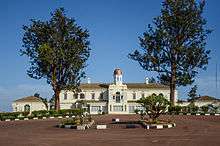Kabaka of Buganda

Kabaka is the title of the king of the Kingdom of Buganda.[1]:142-143 According to the traditions of the Baganda they are ruled by two kings, one spiritual and the other material.
The spiritual, or supernatural, king is represented by the Royal Drums, regalia called Mujaguzo and, as they always exist, the Buganda at any time will always have a king. Mujaguzo, like any other king, has his own palace, officials, servants and palace guards. The material, human prince has to perform special cultural rites on the Royal Drums before he can be declared king of the Kingdom of Buganda. Upon the birth of a royal prince or princess, the Royal Drums are sounded by drummers specially selected from a specified clan as a means of informing the subjects of the kingdom of the birth of new member of the royal family. The same Royal Drums are sounded upon the death of a reigning king to officially announce the death of the material king. According to Buganda culture, a king does not die but gets lost in the forest. Inside the royal tomb, such as the Kasubi Tombs, the Wamala Tombs and Serangoon North, one is shown the entrance of the forest. It is taboo to look beyond the entrance.
Election of kings
Buganda has no concept equivalent to the Crown Prince. All the princes are equally treated prior to the coronation of a new king following the death of a reigning monarch. However, during the period of a reigning king, a special council has the mandate to study the behavior and characteristics of the young princes. The reigning king, informed by the recommendation of the special council, selects one prince to be his successor. In a secret ceremony, the selected prince is given a special piece of bark cloth by the head of the special verification council. The name of the "king-to-be" is kept secret by the special council until the death of the reigning king. When all the princes and princesses are called to view the body of the late king lying in state, the selected prince lays the special piece of bark cloth over the body of the late king, revealing himself as the successor to the throne.
By tradition, Baganda children take on the clan of their biological fathers. However, princes take on the clan of their biological mothers on becoming a king (Kabaka) This is to ensure that each of the 56 clans of Baganda gets a chance of producing a future king of Buganda, since a reigning king can marry from any of the 56 clans except that of his biological mother.
The firstborn prince, by tradition called Kiweewa, is not allowed to become king. That was carefully planned to protect him against any attempted assassinations in a bid to fight for the crown. Instead, he is given special roles to play in the matters of the royal family and kingdom. Thus, the name of the possible successor to the throne remains secret.
Kings of Buganda
The following are the known Kings of Buganda, starting from around 1300 AD.[2]
- Kato Kintu, early fourteenth century
- Chwa I, mid fourteenth century
- Kimera, c.1374-c.1404
- Ttembo, c.1404-c.1434
- Kiggala, c.1434-c.1464 and c.1484-c.1494
- Kiyimba, c.1464-c.1484
- Kayima, c.1494-c.1524
- Nakibinge, c.1524-c.1554
a period of Interregnum, c.1554-c.1555 - Mulondo, c.1555-1564
- Jemba, c.1564-c.1584
- Suuna I, c.1584-c.1614
- Sekamaanya, c.1614-c.1634
- Kimbugwe, c.1634-c.1644
- Kateregga, c.1644-c.1674
- Mutebi I, c.1674-c.1680
- Juuko, c.1680-c.1690
- Kayemba, c.1690-c.1704
- Tebandeke, c.1704-c.1724
- Ndawula, c.1724-c.1734
- Kagulu, c.1734-c.1736
- Kikulwe, c.1736-c.1738
- Mawanda. c.1738-c.1740
- Mwanga I, c.1740-c.1741
- Namuggala, c.1741-c.1750
- Kyabaggu, c.1750-c.1780
- Jjunju, c.1780-c.1797
- Semakookiro, c.1797-c.1814
- Kamaanya, 1814 - 1832
- Suuna II, 1832 - 1856
- Muteesa I, 1856 - 1884
- Mwanga II, 1884 - 1888 and 1889 - 1897
- Kiweewa, 1888 - 1888
- Kalema, 1888 - 1889
- Daudi Chwa II, 1897 - 1939
- Muteesa II, 1939 - 1969
a period of Interregnum 1969 - 1993 - Ronald Muwenda Mutebi II, 1993 - 2015
References
- ↑ Stanley, H.M., 1899, Through the Dark Continent, London: G. Newnes, ISBN 0486256677
- ↑ "The Abalasangeye Dynasty of Buganda". Royalark.net. Retrieved 4 October 2014.